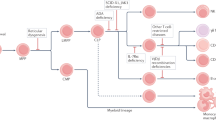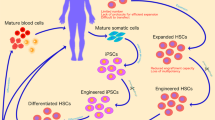Abstract
The concept that the outcome of a devastating disease can be modified by inserting a transgene into abnormal cells is appealing. However, the gene-transfer technologies that are available at present have limited the success of gene therapy so far. Nevertheless, severe combined immunodeficiencies are a useful model, because gene transfer can confer a selective advantage to transduced cells. In this way, a proof of concept for gene therapy has been provided.
This is a preview of subscription content, access via your institution
Access options
Subscribe to this journal
Receive 12 print issues and online access
$209.00 per year
only $17.42 per issue
Buy this article
- Purchase on Springer Link
- Instant access to full article PDF
Prices may be subject to local taxes which are calculated during checkout




Similar content being viewed by others
References
Fischer, A. Primary immunodeficiencies: an experimental model for molecular medicine. Lancet 357, 1863–1869 (2001).
Buckley, R. H. et al. Hematopoietic stem-cell transplantation for the treatment of severe combined immunodeficiency. N. Engl. J. Med. 340, 508–516 (1999).
Haddad, E. et al. Long-term chimerism and B-cell function after bone marrow transplantation in patients with severe combined immunodeficiency with B cells: a single center study of 22 patients. Blood 94, 2923–2930 (1999).
Patel, D. D. et al. Thymic function after hematopoietic stem-cell transplantation for the treatment of severe combined immunodeficiency. N. Engl. J. Med. 342, 1325–1332 (2000).
Blaese, R. M. et al. T-lymphocyte-directed gene therapy for ADA-SCID: initial trial result after 4 years. Science 270, 475–480 (1995).
Onodera, M. et al. Sucessful peripheral T-lymphocyte-directed gene transfer for a patient with severe combined immune deficiency caused by adenosine deaminase deficiency. Blood 91, 30–36 (1999).
Bordignon, C. et al. Gene therapy in peripheral-blood lymphocytes and bone marrow for ADA-immunodeficient patients: gene therapy in peripheral-blood lymphocytes and bone marrow for ADA-immunodeficient patients. Science 270, 470–475 (1995).
Kohn, D. B. et al. Engraftment of gene-modified umbilical-cord blood cells in neonates with adenosine deaminase deficiency. Nature Med. 10, 1017–1023 (1995).
Hoogerbrugge, P. M. et al. Bone-marrow gene transfer in three patients with adenosine deaminase deficiency. Gene Ther. 3, 179–183 (1996).
Cavazzana-Calvo, M. et al. Gene therapy of human severe combined immunodeficiency (SCID)-X1 disease. Science 288, 669–672 (2000).
Giblett, E. R., Anderson, J. E., Cohen, F., Pollara, B. & Meuwissen, H. J. Adenosine-deaminase deficiency in two patients with severely impaired cellular immunity. Lancet 2, 1067–1069 (1972).
Valerio, D. et al. Cloning of human adenosine deaminase cDNA and expression in mouse cells. Gene 31, 147–153 (1984).
Miller, A. D. Retroviral vectors. Curr. Top. Microbiol. Immunol. 158, 1–24 (1992).
Ferrari, G. et al. An in vivo model of somatic-cell gene therapy for human severe combined immunodeficiency. Science 251, 1363–1366 (1991).
Hersfield, M. S. Adenosine deaminase deficiency: clinical expression, molecular basis and therapy. Semin. Hematol. 4, 291–298 (1998).
Kohn, D. B. et al. T lymphocytes with a normal ADA gene accumulate after transplantation of transduced autologous umbilical-cord blood CD34+ cells in ADA-deficient SCID neonates. Nature Med. 4, 775–780 (1998).
Aiuti, F. et al. Immune reconstitution after PBL gene therapy in ADA-deficient SCID: the impact of discontinuation of enzyme replacement therapy. Nature Med. 8, 423–425 (2002).
Blackburn, M. R., Knudsen, T. B. & Kellems, R. E. Genetically engineered mice demonstrate that adenosine deaminase is essential for early postimplantation development. Development 16, 3089–3097 (1997).
Blackburn, M. R., Datta S. K. & Kellems, R. E. Adenosine deaminase deficient mice generated using a two-stage genetic engineering strategy exhibit a combined immunodeficiency. J. Biol. Chem. 273, 5093–5098 (1998).
Anderson, D. C. & Springer, T. A. Leukocyte adhesion deficiency: an inherited defect in the Mac-1, LFA-1 and p150,95 glycoproteins. Annu. Rev. Med. 38, 175–194 (1987).
Segal, B. H., Leto, T. L, Gallin, J. I., Malech, H. L. & Holland, S. M. Genetic, biochemical and clinical features of chronic granulomatous disease. Medicine 79, 170–200 (2000).
Bauer, T. R. Jr & Hickstein, D. D. Gene therapy for leukocyte adhesion deficiency. Curr Opin. Mol. Ther. 4, 383–388 (2000).
Dinauer, M. C., Li, L. L., Bjorgvinsdottirh, H., Ding, C. & Pech, N. Long-term correction of phagocyte NADPH oxidase activity by retroviral-mediated gene transfer in murine X-inked chronic granulomatous disease. Blood 94, 914–922 (1999).
Mardiney, M. III, Jackson, S. H., Spratt, S. K., Li, F., Holland, S. M. & Malech, H. L. Enhanced host defense after gene transfer in the murine p47 phox-deficient model of chronic granulomatous disease. Blood 89, 2268–2275 (1997).
Bauer, T. R., Schwartz, B., Liles, W. C., Ochs, H. D. & Hickstein, D. D. Retroviral-mediated gene transfer of the leukocyte integrin CD18 into peripheral blood CD34+ cells derived from a patient with leukocyte adhesion deficiency type 1. Blood 91, 1520–1526 (1998).
Malech, H. L. et al. Prolonged production of NADPH oxidase-corrected granulocytes after gene therapy of chronic granulomatous disease. Proc. Natl Acad. Sci. USA 94, 12133–12138 (1997).
Malech, H. L. Use of serum-free medium with fibronectin fragment enhanced transduction in a system of gas-permeable plastic containers to achieve high levels of retrovirus transduction at clinical scale. Stem Cells 18, 155–156 (2000).
Dinauer, M. C., Lekstrom-Himes, J. A. & Dale, D. C. Inherited neutrophil disorders: molecular basis and new therapies. Hematology 303–318 (2000).
Kiem, H. P. et al. Gene transfer into marrow repopulating cells: comparison between amphotropic and gibbon ape leukemia virus pseudotyped retroviral vectors in a competitive repopulation assay in baboons. Blood 90, 4638–4645 (1997).
Hanenberg, H. et al. Colocalization of retrovirus and target cells on specific fibronectin fragments increases genetic transduction of mammalian cells. Nature Med. 2, 876–882 (1996).
Noguchi, M. et al. Interleukin-2 receptor γ-chain mutation results in X-linked severe combined immunodeficiency in humans. Cell 73, 147–157 (1993).
Macchi, P. et al. Mutations of Jak-3 gene in patients with autosomal severe combined immune deficiency (SCID). Nature 377, 65–68 (1995).
Russell, S.M. et al. Mutation of Jak3 in a patient with SCID: essential role of Jak3 in lymphoid development. Science 270, 797–800 (1995).
Puel, A, Ziegler, S. F., Buckley, R. H. & Leonard, W. J. Defective IL7Rα expression in T-B+NK+ severe combined immunodeficiency. Nature Genet. 20, 394–397 (1998).
Leonard, W. J. Cytokines and immunodeficiency diseases. Nature Rev. Immunol. 1, 200–208 (2001).
Stephan, V. et al. Atypical X-linked severe combined immunodeficiency due to possible spontaneous reversion of the genetic defect in T cells. N. Engl. J. Med. 335, 1563–1567 (1996).
Bousso, P. et al. Diversity, functionality and stability of the T-cell repertoire derived in vivo from a single human T-cell precursor. Proc. Natl Acad. Sci. USA 97, 274–278 (2000).
Bunting, K. D., Sangster, M. Y., Ihle, J. N. & Sorrentino, B. P. Restoration of lymphocyte function in Janus kinase-3-deficient mice by retroviral-mediated gene transfer. Nature Med. 4, 58–64 (1998).
Bunting, K., Lu, T., Kelly, P. F. & Sorrentino, B. P. Self-selection by genetically modified committed lymphocyte precursors reverses the phenotype of JAK3-deficient mice without myeloblation. Hum. Gene Ther. 11, 2353–2364 (2000).
Lo, M. et al. Restoration of lymphoid populations in a murine model of X-linked severe combined immunodeficiency by a gene-therapy approach. Blood 94, 3027–3038 (1999).
Soudais, C. et al. Stable and functional lymphoid reconstitution of common cytokine receptor γ-chain-deficient mice by retroviral-mediated gene transfer. Blood 95, 3071–3077 (2000).
Otsu, M. et al. Lymphoid development and function in X-linked severe combined immunodeficiency mice after stem-cell gene therapy. Mol. Ther. 1, 145–153 (2000).
Candotti, F., Johnston, J. A., Puck, J. M., Sugamura, K., O'Shea, J. J. & Blaese, R. M. Retroviral-mediated gene correction for X-linked severe combined immunodeficiency. Blood 87, 3097–3102 (1996).
Taylor, N. et al. Correction of interleukin-2 receptor function in X-SCID lymphoblastoid cells by retrovirally mediated transfer of the γc gene. Blood 87, 3103–3107 (1996).
Hacein-Bey, S. et al. γc gene transfer into SCID-X1 patients' B-cell lines restores normal high-affinity interleukin-2 receptor expression and function. Blood 87, 3108–3116 (1996).
Cavazzana-Calvo, M. et al. Role of interleukin-2 (IL-2), IL-7 and IL-15 in natural killer cell differentiation from cord-blood hematopoietic progenitor cells and from γc-transduced severe combined immunodeficiency X1 bone-marrow cells. Blood 88, 3901–3909 (1996).
Hacein-Bey, S., Basile, G. D., Lemerle, J., Fischer, A. & Cavazzana-Calvo, M. γc gene transfer in the presence of stem-cell factor, FLT-3L, interleukin-7 (IL-7), IL-1 and IL-15 cytokines restores T-cell differentiation from γc X-linked severe combined immunodeficiency hematopoietic progenitor cells in murine fetal thymic organ cultures. Blood 92, 4090–4097 (1998).
Hacein-Bey-Abina, S. et al. Sustained correction of human X-linked severe combined immunodeficiency (SCID-X1) by ex vivo gene therapy. N. Engl. J. Med. 346, 1185–1193 (2002).
Kondo, M., Weissman I. L. & Akashi, K. Identification of clonogenic common lymphoid progenitors in mouse bone marrow. Cell 91, 661–672 (1997).
Hao, Q. L. et al. Identification of a novel, human multilymphoid progenitor in cord blood. Blood 12, 3683–3690 (2001).
Hirschhorn, R. et al. Spontaneous in vivo reversion to normal of an inherited mutation in a patient with adenosine deaminase deficiency. Nature Genet. 13, 290–295 (1996).
Schwarz, K. et al. RAG mutations in human B-cell-negative SCID. Science 274, 97–99 (1996).
Moshous, D. et al. Artemis, a novel DNA double-strand break repair/V(D)J recombination protein, is mutated in human severe combined immune deficiency. Cell 105, 177–186 (2001).
Wada, T. et al. Somatic mosaicism in Wiskott–Aldrich syndrome suggests in vivo reversion by a DNA slippage mechanism. Proc. Natl Acad. Sci. USA 98, 8697–8702 (2001).
Snapper, S. B. & Rosen, F. S. The Wiskott–Aldrich syndrome protein (WASP): roles in signaling and cytoskeletal organization. Annu. Rev. Immunol. 17, 905–929 (1999).
Sorrentino, B. P. et al. Selection of drug-resistant bone-marrow cells in vivo after retroviral transfer of human MDR-1. Science 257, 99–103 (1992).
Bonini, C. et al. HSV-TK gene transfer into donor lymphocytes for control of allogeneic graft-versus-leukemia. Science 276, 1719–1724 (1997).
Qin, G. et al. Preselective gene therapy for Fabry disease. Proc. Natl Acad. Sci. USA 98, 3428–3433 (2001).
Kelly, P. F., Vandergriff, J., Nathwani, A., Nienhuis, A. W. & Vanin, E. F. Highly efficient gene transfer into cord-blood nonobese diabetic/severe combined immunodeficiency repopulating cells by oncoretroviral vector particles pseudotyped with the feline endogenous retrovirus (RD114) enveloppe protein. Blood 96, 1206–1214 (2000).
Halene, S. et al. Improved expression in hematopoietic and lymphoid cells in mice after transplantation of bone marrow transduced with a modified retroviral vector. Blood 10, 3349–3357 (1999).
Sadelain, M., Frassoni, F. & Riviere, I. Issues in the manufacture and transplantation of genetically modified hematopoietic stem cells. Curr. Opin. Hematol. 7, 364–377 (2000).
May, C. et al. Therapeutic haemoglobin synthesis in β-thalassaemic mice expressing lentivrirus-encoded human β-globin. Nature 406, 82–86 (2000).
Aiuti, A. et al. Correction of ADA-SCID by stem-cell gene therapy combined with nonmyeloablative conditioning. Science 296, 2410–2413 (2002).
Author information
Authors and Affiliations
Corresponding author
Related links
Related links
DATABASES
Entrez
LocusLink
OMIM
FURTHER INFORMATION
American Society of Gene Therapy
Glossary
- BLOOD APHERESIS
-
The ex vivo selection of blood cells. Unwanted cells are infused back into the donor.
- CDR3-SEQUENCE DETERMINATION
-
Sequencing of the complementarity-determining region 3 (CDR3) of rearranged T-cell receptor genes of individual T-cell clones.
- COMMON LYMPHOID PROGENITOR
-
(CLP). A progenitor that is committed to the lymphoid lineage that can give rise to all lymphocyte subsets, including T cells, B cells and natural killer cells.
- EX VIVO TRANSDUCTION
-
The ex vivo insertion of a transgene into cells. Cells are then placed back into the host.
- V(D)J RECOMBINATION
-
Somatic rearrangement of variable (V), diversity (D) and joining (J) regions of antigen-receptor-encoding genes, which leads to the repertoire diversity of both T- and B-cell receptors.
Rights and permissions
About this article
Cite this article
Fischer, A., Hacein-Bey, S. & Cavazzana-Calvo, M. Gene therapy of severe combined immunodeficiencies. Nat Rev Immunol 2, 615–621 (2002). https://doi.org/10.1038/nri859
Issue Date:
DOI: https://doi.org/10.1038/nri859
This article is cited by
-
Intrathymic injection of hematopoietic progenitor cells establishes functional T cell development in a mouse model of severe combined immunodeficiency
Journal of Hematology & Oncology (2017)
-
Akhil Kakroo
Journal of Clinical Immunology (2005)
-
Allogeneic stem cell transplantation for treatment of immunodeficiency
Springer Seminars in Immunopathology (2004)
-
Cancer gene therapy: an awkward adolescence
Cancer Gene Therapy (2003)
-
Celiac Disease: a model autoimmune disease with gene therapy applications
Gene Therapy (2003)



